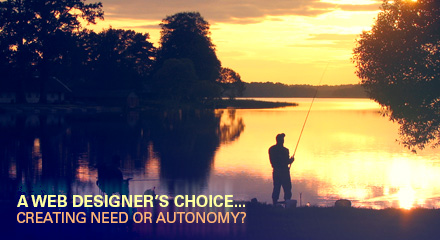There is a Chinese proverb which reads “Give a man a fish and you feed him for a day. Teach a man to fish and you feed him for a lifetime.”. Although you will find divergent opinions in the industry, this proverb illustrates accurately our approach when it comes to web design and development; with WordPress, the easiest and most popular Content Management System on the web, we build solutions which give our clients full autonomy of the content to be published on their newly created site.
Not all web developers agree on that matter however. While we feel pride in teaching our clients to become independent and responsible of their website, a joint creation based on their vision and our expertise, several designers prefer to leave clients in the dark and therefore create a need. Having the clients return to you constantly can indeed be profitable financially, but is it the right thing to do?
Why giving clients autonomy?
Indeed, why should we teach our clients how to update their website alone when we could let them in the dark and charge for each modification (or, in some cases, give a free grace period at the end which all modifications become costly)? For a business, wouldn’t it make more sense to provide solutions that would force the clients to come back and spend each time, resulting in more money and more control?
First, our end-goal at Veodesign is not to make money. Sounds unbelievable? Hear me out. If you know us a bit, either by having worked with us, read our about page or read out blog, you know already we are a team of passionate individuals who love to help people. Helping businesses, projects and people grow is our end goal. Through our business and using our design and programming skills, we provide means for people like you, like us, to achieve their goals. Money-making is a necessity in the society we live in, so we do charge for our services, but it is not our number one priority. Therefore, it would be sabotaging ourselves to take away freedom which could profit our clients, a freedom they acquire thanks to the marvels of WordPress. WordPress is a platform which, once integrated to the unique and custom-made templates we create for our clients, will make it easy for clients to update all the content of their websites without having to pay an extra fee.
We give all our clients that option not only because we believe it’s the right thing to do, but also because we know this autonomy will help them achieve their goals through management and understanding of their own website.
Of course, if a client doesn’t want WordPress, we don’t force it on them; we merely offer it as a complete solution. As all projects are different, it is possible that for some, WordPress might not be the optimal solution. It’s rare we encounter such situations for small and medium business models, but it does happen. The trick is to be flexible and ready to explore other solutions, which we do each time.
Does autonomy mean losing clients and money?
I understand how this could be a worry for many small design firms like ours. When you give your clients autonomy, you relinquish some control you would otherwise have other them. While we are perfectly happy to do so, preferring to seek new projects instead of tweaking the same websites’ content over and over, creating need can be a secure blanket designers and developers rely on.
The way I see it, if we provide our clients with complete solutions that satisfy all their needs and make them happy, they will very often gladly refer you to their friends and/or colleagues. We see no need in keeping total control over the website because we trust our clients to come back to us if they need more complex changes, which they always do. In fact, if you make them happy, why would they look elsewhere? It can happen, but in our experience, our clients have always been very loyal (and we are very grateful).
We might not be making quick money by providing obligatory paid changes to the content of our clients’ websites, but we do get a fairly constant flow of contracts as well as frequent referrals. And if you allow me to be perfectly honest with you, I would much rather focus my attention on new projects than dwell on the same websites for months and months (or years and years), adding content here, content there, every time a client wants to make a tiny change. I like our clients happy, independent, informed and growing their business and website. In the meantime, we are always there for them if they have questions or doubts, or if they need more complex (paid) changes.
Conclusion: Priorities and decisions
It is in the end the design firm’s decision to make; what do you want to give your clients? What does your client need in order to grow? If you, the designer or developer, believe firmly the client doesn’t need a CMS like WordPress, and therefore doesn’t require autonomy, then you are in your right to build a static website instead. My position on the subject however is that it should at least be offered as an option, and discussed with the client. You might be surprised to find many of them are genuinely interested in the easy management of their website. And it’s understandable; the final website will be afterall their baby too, a mirror of their company.
What is your opinion? Should clients be given autonomy or not?
